

Delivery of crop pollination services is an insufficient argument for wild pollinator conservation : Nature Communications. Data sets to study crop visitation by bees Our data sets record the relative visitation rate of bees to crop flowers, which is a good proxy for the relative contribution to pollination service delivery (see next section).
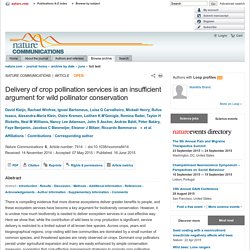
We used data from 90 studies and 1,394 crop fields around the world that used standardized protocols to examine the abundance and identity of wild bees visiting flowers of 20 different crops that depend on bee pollinators for maximum yield (Supplementary Fig. 1 and Supplementary Table 1). We determined species abundance distributions of wild bee communities on insect-pollinated crops by pooling data within studies, that is, from fields sampled in the same year, region and crop species. We only included studies that directly observed individual bees on crop flowers, identified all individuals to species level and that were based on data from at least four fields that were 1 km or more apart.
The Tree of Life. Ple. ORGANICA. Day One. The meeting began with a brief introduction by John Dupré.

Humanity is Waking Up to the Intelligence of Nature. Paul Lenda, GuestWaking Times There’s a heightening level of awareness within the human race with regards to nature and all that is contained within it.
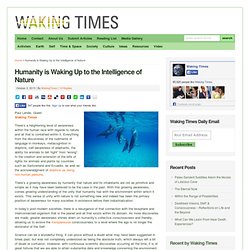
Everything from the discoveries of the rudiments of language in monkeys, metacognition in dolphins, self-awareness of elephants, the ability for animals to tell “right” from “wrong”, to the creation and extension of the bills of rights for animals and plants by countries such as Switzerland and Ecuador, as well as the acknowledgment of dolphins as being non-human persons. There’s a growing awareness by humanity that nature and its inhabitants are not as primitive and simple as it may have been believed to be the case in the past.
With this growing awareness, comes growing understanding of the unity that humanity has with the environment within which it exists.
Animalia. Apiary. Scientists discover what’s killing the bees and it’s worse than you thought - Quartz. Universal Basic Income (UBI) proposals are gaining in popularity across the political spectrum.
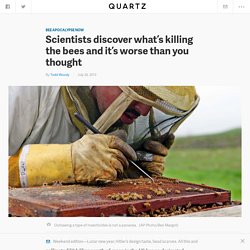
The measures would see governments hand a set monthly income to every single citizen within a country, either in addition to existing benefits or in place of them (depending on the details of the particular UBI proposal). Left-wing fans favor UBI’s ability to eradicate absolute poverty, while right-wing libertarians are drawn to its simplicity and reduction in bureaucracy. In Silicon Valley, startup investment firm Y Combinator has plans to fund a basic income experiment in the US, while Finland announced last year it would conduct its own extensive experiment.
Plants. Largest Living Thing. Home > Animal Kingdom > Animal Records > Largest Living Thing Largest Living Organism: Fungus Armillaria ostoyae A Fungus Among Us.
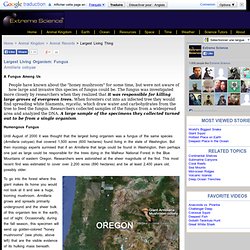
Agros Cultura. Ethnobotany. Gardens Delight. The Therapeutic Garden: A Definition. Design in health care settings is typically the work of garden or landscape designers rather than landscape architects.
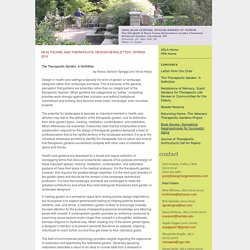
Food Fare. Tending Produce. Antarah Organica. Food Organizations. Life Sciences. Land Water BioMass. Greywater Recycling. 7 characteristics of living things. Organization of Life. Inquiry of Life Science (Book notes & Extentions) Nature Blows My Mind ! TreeHugger. TreeHugger Nature Blows My Mind.
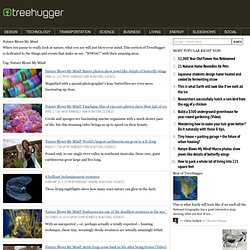
EO Wilson Biodiversity Foundation - The Processes that Matter. Ask Nature - the Biomimicry Design Portal: biomimetics, architecture, biology, innovation inspired by nature, industrial design - Ask Nature - the Biomimicry Design Portal: biomimetics, architecture, biology, innovation inspired by nature, industrial desi. New Healthy Energy. New Body Health. REALLY GOOD STUFF. Engaging with Indigenous Peoples on forests.
A little while ago, I blogged about an unprecedented meeting of Indigenous Peoples’ representatives from 28 countries that took place on the idyllic islands of Guna Yala, Panama, in September 2011.
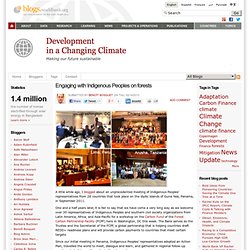
One and a half years later, it is fair to say that we have come a very long way as we welcome over 30 representatives of Indigenous Peoples and southern civil society organizations from Latin America, Africa, and Asia-Pacific for a workshop on the Carbon Fund of the Forest Carbon Partnership Facility (FCPF) here in Washington, DC this week. The Bank serves as the Trustee and the Secretariat of the FCPF, a global partnership that is helping countries draft REDD+ readiness plans and will provide carbon payments to countries that meet certain targets. Since our initial meeting in Panama, Indigenous Peoples’ representatives adopted an Action Plan, travelled the world to meet, dialogue and learn, and gathered in regional follow-up meetings to build capacity and prioritize demands. The outlook: Averting the sixth extinction.
What Is Biodynamics? Beetle bank. A strip around a field left fallow to serve as a beetle bank.
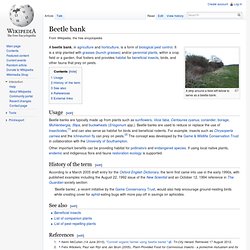
Usage[edit] Beetle banks are typically made up from plants such as sunflowers, Vicia faba, Centaurea cyanus, coriander, borage, Muhlenbergia, Stipa, and buckwheats (Eriogonum spp.). Beetle banks are used to reduce or replace the use of insecticides,[1] and can also serve as habitat for birds and beneficial rodents. For example, insects such as Chrysoperla carnea and the Ichneumon fly can prey on pests.[2] The concept was developed by the Game & Wildlife Conservation Trust in collaboration with the University of Southampton.
Other important benefits can be providing habitat for pollinators and endangered species. History of the term[edit] GFU for Underutilized Species. Communication and conflict resolution.